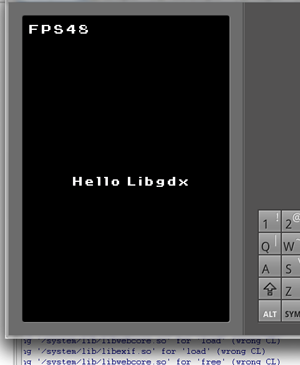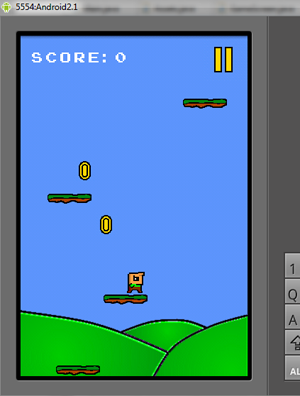转载自:http://blog.csdn.net/cping1982/article/details/6176191
Libgdx作者博客:http://www.badlogicgames.com/
Libgdx项目地址:http://code.google.com/p/libgdx/
Libgdx是一款支持2D与3D游戏开发的游戏类库,兼容大多数微机平台(标准JavaSE实现,能执行在Mac、Linux、Windows等系统)与Android平台(Android1.5以上就可以使用。Android2.1以上可满功率发挥),
Libgdx由audio、files、graphics、math、physics、scenes、utils这些主要类库所组成,它们分别相应了Libgdx中的音频操作,文件读取,2D/3D渲染,Libgdx画图相关运算。Box2D封装,2D/3D游戏组件(3D部分眼下无组件),以及Libgdx内置工具类。
Libgdx主要构成例如以下所看到的(Libgdx作者wiki提供):

以下開始。我将就Libgdx的详细实现,開始解说怎样正确使用Libgdx类库。
只是在正式開始之前。我们首先还得讲讲Gdx类。
关于Libgdx中的Gdx类:
单从表面上看。Gdx类占用空间不足2KB,甚至不具备一行能够被直接运行的函数,并没什么重要好说。
然而,真实的Gdx却是Libgdx类库执行的核心所在,没有它你将寸步难行,不单执行Graphics、Input、Files、Audio、AndroidApplication等Libgdx关键部分所必需的实例会在Libgdx初始化时注入Gdx中相应的graphics、input、files、audio、app等静态变量里面,就连Libgdx对OpenGL接口(或OpenGLES,视Libgdx执行平台而定。下面统称OpenGL)的GL10、GL11、GL20、GLCommon等封装类也会在Graphics实例化时分别注入到gl10、gl11、gl20、gl这四个相同位于Gdx的静态变量其中(在Graphics中也会继续保留它们的引用,因此不管你执行Gdx.graphics.getGL10还是Gdx.gl10。其实都在调用同一个静态变量)。其实,假设你想不使用Gdx而正常执行Libgdx,那么除了重构源代码,就再没有不论什么办法可想了。
PS:假设你不清楚自己到底在什么环境使用Libgdx,事实上也不必强分gl10或gl11,大能够通过Gdx.gl方式调用Libgdx中对于OpenGL接口的默认封装(运行某些非多版本号共同拥有接口时。依然须要使用相应版本号专属gl)。
想要使用Libgdx。却不明确Gdx是干什么用的。那么一切就都是空谈。
以下開始,我将详细解说Libgdx中的图像处理与游戏组件部分:
关于Libgdx的图像处理部分:
Mesh:
本质上讲,Libgdx中全部可见的3D物体首先都是一个Mesh(网格,或者说三维网格形式的高级图元)。Mesh是怎样生成的呢?众所周知,数学上讲的立体几何由点、线、面三部分组成,不管多么复杂的图像也能够分解为无数细小的这三部分。或者说能够由很基础的N个这三部分所组合而成。到了3D游戏开发时。当我们要构建复杂的3D图像,首先会以一系列有序的vertices(顶点)构成这些详细的点、线、三角要素。即构成画图基本图元(Primitives),再将基本图元组合成更完整的高级图元也就是详细3D对象。
因此,假设对Mesh概念进行简单的理解,事实上它就是一个象征完整图像的基本图元集合体,Libgdx先让我们把一个个细分的vertices组成基本图元,再由Mesh类将基本图元制成更加复杂的高级图元展示出来。
详细可见Libgdx作者提供的returntomarchfeld演示样例,基本效果例如以下图所看到的:

(勿看FPS。一切信真机)
PS:假设对此类认识不足,能够去玩玩模拟人生。下个改动器尝试编辑角色或物品造型后就懂了……
Texture:
Libgdx所提供的游戏纹理用类,事实上质可理解为保存在显存中的Image,它以贴图的方式通过OpenGL将图片显示到游戏界面之上。Libgdx的纹理能够直接从指定文件路径载入。也能够通过它提供的Pixmap类凭空创建(它的Texture(int width, int height, Format format)构造内部直接调用了Pixmap,不是必须在外部生成Pixmap后注入)。
另外在载入Texture时,个人建议通过Libgdx提供的TextureDict.loadTexture函数调用,该方法内部提供了Texture缓存管理,能够避免无意义的资源反复载入。此外,Texture一般会与TextureRegion类配套使用。利用TextureRegion包装Texture后,再利用SpriteBatch进行绘制,能够非常方便的修订Texture为我们须要的显示范围。还有。Libgdx中Sprite类为TextureRegion子类,因此能够将Sprite当作TextureRegion来使用,仅仅是Sprite类比TextureRegion有所扩展。只是Libgdx的SpriteCache类并没有继承Sprite或TextureRegion,所以起不到TextureRegion的作用,仅仅能构建一组静态贴图集合罢了。特此说明。
- // Libgdx的Texture与Sprite使用
- public class Main extends AndroidApplication {
- class TestSprite implements ApplicationListener {
- // 准备画图用SpriteBatch
- SpriteBatch spriteBatch;
- // 准备游戏精灵
- Sprite sprite;
- // 准备图片载入用Texture
- Texture texture;
- public void create() {
- // 构建SpriteBatch
- spriteBatch = new SpriteBatch();
- // 构建Texture。图像宽与高大小都必须为2的整数次幂,否则提示异常
- // PS:在Android环境使用Libgdx的internal载入时必须文件必须位于assets文件夹下
- texture = new Texture(Gdx.files.internal("mySprite.png"));
- // 以指定Texture构建Sprite
- sprite = new Sprite(texture);
- // 定位到100, 180(Libgdx使用标准笛卡尔坐标系。自左下0,0開始)
- sprite.setPosition(100, 180);
- }
- public void render() {
- // 清屏
- Gdx.gl.glClear(GL10.GL_COLOR_BUFFER_BIT);
- // 初始化画图调用
- spriteBatch.begin();
- // 绘制精灵到游戏屏幕
- sprite.draw(spriteBatch);
- // 结束画图调用
- spriteBatch.end();
- }
- public void dispose() {
- // 释放占用的资源
- spriteBatch.dispose();
- texture.dispose();
- }
- public void resume() {
- }
- public void pause() {
- }
- public void resize(int width, int height) {
- }
- }
- public void onCreate(Bundle bundle) {
- super.onCreate(bundle);
- // 初始化游戏屏幕,并设置是否支持GLES 2.0。假设您对向下兼容没什么须要选择true就可以(2.1以上),否则选择false。
- initialize(new TestSprite(), true);
- }
- }
Pixmap:
Libgdx所提供的像素级图像渲染用类。因为Libgdx眼下以JNI方式自带图像解码器,所以我们能够直接将Pixmap理解为一个Android中Bitmap的替代者。两者间实现细节虽有区别。但详细作用却大同小异。Pixmap支持Alpha、LuminanceAlpha、RGB565、RGBA4444、RGB888、RGBA8888等五种图像彩色模式。支持png、jpg、bmp等三种图像文件的读取和载入。
一般来说,Pixmap必须和Texture混用才干真正显示画面。只是在其实,Libgdx的Texture里已经内置有Pixmap了。
- // Libgdx的Pixmap使用
- public class Main extends AndroidApplication {
- class TestPixmap implements ApplicationListener {
- // 准备画图用SpriteBatch
- SpriteBatch spriteBatch;
- // Pixmap是Libgdx提供的针对opengl像素操作的上级封装,它能够凭空构建一个像素贴图,
- // 可是它的现实必须通过Texture。
- Pixmap pixmap;
- // 准备Texture
- Texture texture;
- public void create() {
- // 构建SpriteBatch
- spriteBatch = new SpriteBatch();
- // 构建Pixmap(在Android环境使用internal载入模式时,文件必须放置于assets目录下)
- pixmap = new Pixmap(Gdx.files.internal("myPixmap.png"));
- // 绘制一个蓝方块到Ball图像之上
- pixmap.setColor(Color.BLUE.r, Color.BLUE.g, Color.BLUE.b,
- Color.BLUE.a);
- pixmap.drawRectangle(15, 15, 40, 40);
- // 以指定Pixmap构建Texture
- texture = new Texture(pixmap);
- // 注入Texture后的pixmap已经没用,能够注销
- pixmap.dispose();
- }
- public void dispose() {
- spriteBatch.dispose();
- texture.dispose();
- }
- public void pause() {
- }
- public void render() {
- // 清屏
- Gdx.gl.glClear(GL10.GL_COLOR_BUFFER_BIT);
- // 初始化画图调用
- spriteBatch.begin();
- // 绘制精灵到游戏屏幕
- spriteBatch.draw(texture, 100, 180);
- // 结束画图调用
- spriteBatch.end();
- }
- public void resize(int width, int height) {
- }
- public void resume() {
- }
- }
- public void onCreate(Bundle bundle) {
- super.onCreate(bundle);
- // 初始化游戏屏幕,并设置是否支持GLES 2.0,假设您对向下兼容没什么须要选择true就可以(2.1以上),否则选择false。
- initialize(new TestPixmap(), true);
- }
- }
BitmapFont:
Libgdx所提供的OpenGL文字用类,构造BitmapFont时须要一个描写叙述文字构成的fnt文件,和一个提供文字图片的png文件(PS:在Libgdx的com.badlogic.gdx.utils包下有提供内置字库,眼下仅支持英文、数字和常见符号),同SpriteBatch相配合时可以完毕一些基础的文字画图。值得一提的是,我们也可以使用BitmapFontCache类将BitmapFont包装成了一个静态的Font实例,以避免大量贴图时产生的不必要损耗。
- //libgdx的文字显示
- public class Main extends AndroidApplication {
- class TestFont extends Game {
- // SpriteBatch是libgdx提供的opengl封装,能够在当中运行一些常规的图像渲染,
- // 而且libgdx所提供的大多数图形功能也是环绕它建立的。
- SpriteBatch spriteBatch;
- // BitmapFont是libgdx提供的文字显示用类,内部将图片转化为可供opengl调用的
- // 文字贴图(默认不支持中文)。
- BitmapFont font;
- public void create() {
- //构建SpriteBatch用于图像处理(内部调用opengl或opengles)
- spriteBatch = new SpriteBatch();
- //构建BitmapFont,必须有一个fnt文件描写叙述文字构成,一个图片文件提供文字用图
- font = new BitmapFont(Gdx.files.internal("font.fnt"), Gdx.files
- .internal("font.png"), false);
- }
- public void render() {
- // 调用清屏
- Gdx.gl.glClear(GL10.GL_COLOR_BUFFER_BIT);
- // 初始要有begin起始
- spriteBatch.begin();
- // 显示文字到屏幕指定位置
- // PS:Libgdx採用标准笛卡尔坐标系,自左下0,0開始
- font.draw(spriteBatch, "FPS" + Gdx.graphics.getFramesPerSecond(),
- 5, 475);
- font.draw(spriteBatch, "Hello Libgdx", 255, 255);
- // 结束要有end结尾
- spriteBatch.end();
- }
- public void resize(int width, int height) {
- }
- public void pause() {
- }
- public void resume() {
- }
- public void dispose() {
- // 释放占用的资源
- spriteBatch.dispose();
- font.dispose();
- }
- }
- public void onCreate(Bundle bundle) {
- super.onCreate(bundle);
- // 初始化游戏屏幕,并设置是否支持GLES 2.0,假设您对向下兼容没什么须要选择true就可以(2.1以上),否则选择false。
- initialize(new TestFont(), true);
- }
- }

SpriteBatch:
Libgdx所提供的纹理渲染器,本质上是OpenGL的简易封装体,详细实现上与XNA中的SpriteBatch类很近似,每次调用SpriteBatch类都必须以begin函数开头,以end函数结尾。因为Libgdx中SpriteBatch提供的功能还很有限,所以在全然不懂OpenGL的前提下使用其进行游戏开发也许有一定难度。
ShaderProgram:
Libgdx所提供的着色器,在Android环境使用时须要GLES2.0或以上版本号才干完整支持的高级渲染功能之中的一个。内部封装着GLES2.0专用的顶点着色与片断着色Shader Model,它的本质作用是对3D对象表面进行渲染处理,此物性能基本取决于GPU(除了Google Nexus系列手机暂未见能全然跑出速度的机型)。
- //libgdx的ShaderProgram使用
- public class Main extends AndroidApplication {
- class TestShader implements ApplicationListener {
- ShaderProgram shader;
- Texture texture;
- Texture texture2;
- Mesh mesh;
- public void create() {
- // 下面命令供GPU使用(不支持GLES2.0就不用跑了)
- String vertexShader = "attribute vec4 a_position; /n"
- + "attribute vec2 a_texCoord; /n"
- + "varying vec2 v_texCoord; /n"
- + "void main() /n"
- + "{ /n"
- + " gl_Position = a_position; /n"
- + " v_texCoord = a_texCoord; /n"
- + "} /n";
- String fragmentShader = "#ifdef GL_ES/n"
- + "precision mediump float;/n"
- + "#endif/n"
- + "varying vec2 v_texCoord; /n"
- + "uniform sampler2D s_texture; /n"
- + "uniform sampler2D s_texture2; /n"
- + "void main() /n"
- + "{ /n"
- + " gl_FragColor = texture2D( s_texture, v_texCoord ) * texture2D( s_texture2, v_texCoord);/n"
- + "} /n";
- // 构建ShaderProgram
- shader = new ShaderProgram(vertexShader, fragmentShader);
- // 构建网格对象
- mesh = new Mesh(true, 4, 6, new VertexAttribute(Usage.Position, 2,
- "a_position"), new VertexAttribute(
- Usage.TextureCoordinates, 2, "a_texCoord"));
- float[] vertices = { -0.5f, 0.5f, 0.0f, 0.0f, -0.5f, -0.5f, 0.0f,
- 1.0f, 0.5f, -0.5f, 1.0f, 1.0f, 0.5f, 0.5f, 1.0f, 0.0f };
- short[] indices = { 0, 1, 2, 0, 2, 3 };
- // 注入定点坐标
- mesh.setVertices(vertices);
- mesh.setIndices(indices);
- // 以Pixmap生成两个指定内容的Texture
- Pixmap pixmap = new Pixmap(256, 256, Format.RGBA8888);
- pixmap.setColor(1, 1, 1, 1);
- pixmap.fill();
- pixmap.setColor(0, 0, 0, 1);
- pixmap.drawLine(0, 0, 256, 256);
- pixmap.drawLine(256, 0, 0, 256);
- texture = new Texture(pixmap);
- pixmap.dispose();
- pixmap = new Pixmap(256, 256, Format.RGBA8888);
- pixmap.setColor(1, 1, 1, 1);
- pixmap.fill();
- pixmap.setColor(0, 0, 0, 1);
- pixmap.drawLine(128, 0, 128, 256);
- texture2 = new Texture(pixmap);
- pixmap.dispose();
- }
- public void dispose() {
- }
- public void pause() {
- }
- public void render() {
- // PS:因为使用了ShaderProgram,因此必须配合gl20模式(否则缺少关键opengles接口)
- Gdx.gl20.glViewport(0, 0, Gdx.graphics.getWidth(), Gdx.graphics
- .getHeight());
- Gdx.gl20.glClear(GL20.GL_COLOR_BUFFER_BIT);
- Gdx.gl20.glActiveTexture(GL20.GL_TEXTURE0);
- texture.bind();
- Gdx.gl20.glActiveTexture(GL20.GL_TEXTURE1);
- texture2.bind();
- // 開始使用ShaderProgram渲染
- shader.begin();
- shader.setUniformi("s_texture", 0);
- shader.setUniformi("s_texture2", 1);
- mesh.render(shader, GL20.GL_TRIANGLES);
- // 结束ShaderProgram渲染
- shader.end();
- }
- public void resize(int width, int height) {
- }
- public void resume() {
- }
- }
- public void onCreate(Bundle bundle) {
- super.onCreate(bundle);
- // 初始化游戏屏幕,并设置是否支持GLES 2.0。假设您对向下兼容没什么须要选择true就可以(2.1以上),否则选择false。
- initialize(new TestShader(), true);
- }
- }
FrameBuffer:
Libgdx所提供的帧缓冲器,在Android环境使用时须要GLES2.0或以上版本号才干完整支持的高级渲染功能之中的一个。也就是常说的FrameBuffer Object(FBO)功能封装(用过JavaSE或JavaME开发游戏的朋友,画图时大概都接触过双缓存这个概念。尽管有所区别。只是将FrameBuffer理解成起近似作用也未尝不可)此物性能彻底取决于GPU(除了Google Nexus系列手机暂未见能全然跑出速度的机型)。
- //libgdx的FrameBuffer使用
- public class Main extends AndroidApplication {
- class TestFrameBuffer implements ApplicationListener {
- FrameBuffer frameBuffer;
- Mesh mesh;
- ShaderProgram meshShader;
- Texture texture;
- SpriteBatch spriteBatch;
- // PS:假设不支持GLES2.0就不用试了
- public void create() {
- mesh = new Mesh(true, 3, 0, new VertexAttribute(Usage.Position, 3,
- "a_Position"), new VertexAttribute(Usage.ColorPacked, 4,
- "a_Color"), new VertexAttribute(Usage.TextureCoordinates,
- 2, "a_texCoords"));
- float c1 = Color.toFloatBits(255, 0, 0, 255);
- float c2 = Color.toFloatBits(255, 0, 0, 255);
- float c3 = Color.toFloatBits(0, 0, 255, 255);
- mesh.setVertices(new float[] { -0.5f, -0.5f, 0, c1, 0, 0, 0.5f,
- -0.5f, 0, c2, 1, 0, 0, 0.5f, 0, c3, 0.5f, 1 });
- texture = new Texture(Gdx.files.internal("myTest.png"));
- spriteBatch = new SpriteBatch();
- frameBuffer = new FrameBuffer(Format.RGB565, 128, 128, true);
- String vertexShader = "attribute vec4 a_Position; /n"
- + "attribute vec4 a_Color;/n"
- + "attribute vec2 a_texCoords;/n" + "varying vec4 v_Color;"
- + "varying vec2 v_texCoords; /n" +
- "void main() /n"
- + "{ /n"
- + " v_Color = a_Color;"
- + " v_texCoords = a_texCoords;/n"
- + " gl_Position = a_Position; /n"
- + "} /n";
- String fragmentShader = "precision mediump float;/n"
- + "varying vec4 v_Color;/n"
- + "varying vec2 v_texCoords; /n"
- + "uniform sampler2D u_texture;/n"
- +
- "void main() /n"
- + "{ /n"
- + " gl_FragColor = v_Color * texture2D(u_texture, v_texCoords);/n"
- + "}";
- meshShader = new ShaderProgram(vertexShader, fragmentShader);
- if (meshShader.isCompiled() == false)
- throw new IllegalStateException(meshShader.getLog());
- }
- public void dispose() {
- }
- public void pause() {
- }
- public void render() {
- frameBuffer.begin();
- Gdx.graphics.getGL20().glViewport(0, 0, frameBuffer.getWidth(),
- frameBuffer.getHeight());
- Gdx.graphics.getGL20().glClearColor(0f, 1f, 0f, 1);
- Gdx.graphics.getGL20().glClear(GL20.GL_COLOR_BUFFER_BIT);
- Gdx.graphics.getGL20().glEnable(GL20.GL_TEXTURE_2D);
- texture.bind();
- meshShader.begin();
- meshShader.setUniformi("u_texture", 0);
- mesh.render(meshShader, GL20.GL_TRIANGLES);
- meshShader.end();
- frameBuffer.end();
- Gdx.graphics.getGL20().glViewport(0, 0, Gdx.graphics.getWidth(),
- Gdx.graphics.getHeight());
- Gdx.graphics.getGL20().glClearColor(0.2f, 0.2f, 0.2f, 1);
- Gdx.graphics.getGL20().glClear(GL20.GL_COLOR_BUFFER_BIT);
- spriteBatch.begin();
- spriteBatch.draw(frameBuffer.getColorBufferTexture(), 0, 0, 256,
- 256, 0, 0, frameBuffer.getColorBufferTexture().getWidth(),
- frameBuffer.getColorBufferTexture().getHeight(), false,
- true);
- spriteBatch.end();
- }
- public void resize(int width, int height) {
- }
- public void resume() {
- }
- }
- public void onCreate(Bundle bundle) {
- super.onCreate(bundle);
- // 初始化游戏屏幕,并设置是否支持GLES 2.0。假设您对向下兼容没什么须要选择true就可以(2.1以上),否则选择false。
- initialize(new TestFrameBuffer(), true);
- }
- }
关于Libgdx的游戏组件部分:
在近期更新的Libgdx中,与游戏显示相关度最高的包总共同拥有两个,一个是graphics包,当中包括着Libgdx为进行OpenGL渲染所提供的功能实现,而还有一个,就是以下介绍的scenes包。这里包括着Libgdx所提供的能够直接使用到游戏中的游戏组件,共分scenes2d以及scenes3d两大部分(3D部分暂无内容)。当中2D部分的核心在于Actor类,Libgdx全部2D组件使用都环绕着Actor展开。
对于Libgdx中游戏组件使用的简单关系说明:
AndroidApplication(Activity的子类,仅仅有启动类继承了AndroidApplication并运行才干启动Libgdx类库)
|
ApplicationListener(仅可在初始化时注入ApplicationListener。此后除非替换Activity否则无法切换ApplicationListener) -
Game(ApplicationListener的libgdx抽象实现。当中Screen可切换)
|
Screen(基本函数与ApplicationListener近乎一致,唯一区别在于能够通过Game类用setScreen函数进行切换。如不使用Game类则可无视它的存在)
|
Stage (游戏场景用类,用以管理加入当中的详细Actor,管理Actor的手段在于内置的Group类)
|
Group (本身为Actor的详细实现,可以处理注入当中的Actor,也能以递归方式管理注入当中的其他Group)
|
Actor (游戏用演员或者说角色,与Action类组合使用时能够产生不同种类的“动画行为”,Action部分的详细实现基本与Cocos2D一致)
|
Image、Button、Label等(细分Actor的详细实现,以重载方式响应事件。除Group外相互间不能组合叠加,事件是否能传递取决于上级组件是否设置了相关监听)
- //Libgdx中Actor的使用
- public class Main extends AndroidApplication {
- class TestActor implements ApplicationListener {
- Stage stage;
- public void create() {
- //构建等值于屏幕大小的场景
- stage = new Stage(Gdx.graphics.getWidth(), Gdx.graphics.getHeight(), false);
- // 构建Button
- Button btn = new Button("btn1", TextureDict.loadTexture("myButton.png")
- .get()) {
- // PS:由于Libgdx的touchDown有内部实现。所以重载touchDown时必须调用super方法(肯定没LGame方便啦^^~)
- protected boolean touchDown(float x, float y, int pointer) {
- super.touchDown(x, y, pointer);
- Gdx.app.log("click", "x:"+x+",y:"+y);
- return true;
- }
- };
- btn.x = 55;
- btn.y = 55;
- stage.addActor(btn);
- // 注入Stage监听。让Stage响应窗口事件,必须。(否则不管注入Stage什么Actor都不会响应事件)
- Gdx.input.setInputProcessor(stage);
- }
- public void dispose() {
- stage.dispose();
- }
- public void pause() {
- }
- public void render() {
- // 绘制stage到屏幕
- stage.render();
- // PS:Libgdx不管游戏业务或游戏画图刷新都经过render
- // 传递屏幕刷新时间给stage,以运行内部业务操作,假设没有这步,则全部注入Stage中Actor的act方法无法运行
- stage.act(Gdx.graphics.getDeltaTime());
- }
- public void resize(int width, int height) {
- }
- public void resume() {
- }
- }
- public void onCreate(Bundle bundle) {
- super.onCreate(bundle);
- // 初始化游戏屏幕,并设置是否支持GLES 2.0,假设您对向下兼容没什么须要选择true就可以(2.1以上)。否则选择false。
- initialize(new TestActor(), true);
- }
- }
- //Libgdx中Action的使用
- public class Main extends AndroidApplication {
- class TestAction implements ApplicationListener {
- Stage stage;
- Texture texture;
- public void create() {
- // 构建场景
- stage = new Stage(Gdx.graphics.getWidth(),
- Gdx.graphics.getHeight(), false);
- // 构建纹理
- texture = new Texture(Gdx.files.internal("myImage.png"));
- texture.setFilter(TextureFilter.Linear, TextureFilter.Linear);
- // 构建图像精灵
- Image img = new Image("actor", texture);
- img.width = img.height = 100;
- img.x = img.y = 100;
- // 依次让图像使用下列动作(PS:“$”符号为调用相应Action类的静态函数名,就那么起的罢了(只是有缓存)……)
- img.action(Forever.$(Sequence.$(ScaleTo.$(1.1f, 1.1f, 0.3f),
- ScaleTo.$(1f, 1f, 0.3f))));
- stage.addActor(img);
- }
- public void render() {
- Gdx.gl.glClear(GL10.GL_COLOR_BUFFER_BIT);
- stage.act(Gdx.graphics.getDeltaTime());
- stage.render();
- }
- public void dispose() {
- texture.dispose();
- stage.dispose();
- }
- public void pause() {
- }
- public void resize(int width, int height) {
- }
- public void resume() {
- }
- }
- public void onCreate(Bundle bundle) {
- super.onCreate(bundle);
- // 初始化游戏屏幕,并设置是否支持GLES 2.0,假设您对向下兼容没什么须要选择true就可以(2.1以上),否则选择false。
- initialize(new TestAction(), true);
- }
- }
就眼下来说,Libgdx可用的游戏组件相对照较稀少,部分功能或者须要用户自行实现。只是近期有一位网名moritz的手机游戏“半全职”开发人员(由于他自己说手机游戏并非他唯一的收入来源)已经增加Libgdx项目,未来将重点改进Libgdx的scene2d部分,鉴于Libgdx作者为此特意写了一篇名为“welcome moritz”的博文,moritz此人应该是有一定能力的家伙,对于Lingdx未来表现大约还是值得期待的(话说,莫非moritz仅仅对改造Libgdx的2D模块有兴趣?Libgdx作者博文中提到眼下moritz开发的3D游戏没有使用Libgdx——那啥,先把3D组件部分做出来吧。如今是NULL啊……)。
在Libgdx的SVN,也有一些详细的游戏演示样例,大家能够下载后亲身体验其效果。

PS:为体现Libgdx最新特性,上述演示样例使用的Libgdx是2月1日从Libgdx SVN下载的版本号(2011年1月28日更新版)。请自行下载相关类库,以保证所用版本号维持在最新。
附录,使用Libgdx时的几点注意事项:
1、Libgdx使用笛卡尔坐标系(初始坐标为左下0,0),而JavaSE、JavaME以及标准Android系统(还有LGame引擎)使用的是屏幕坐标系(初始坐标为左上0,0),程序猿在使用时必须分清区别。以免不知道怎样定位(通常笛卡尔系Y轴由下向上延伸。屏幕系Y轴由上向下延伸)。
2、在Android环境使用Libgdx的Gdx.files.internal方法时(即FileHandle类以FileType.Internal模式工作),要读取的文件必须置于Assets目录下才干读取,在Linux、Mac、Windows环境下则能够置于除jar内部外的不论什么可读取位置。
3、Libgdx以native方式自带图像解码器,通过其提供的Pixmap能够对指定图像进行像素级渲染操作,从而不依赖Android的Bitmap载入处理图像。只是眼下仅仅支持png、jpg、bmp三种图片格式。
4、Libgdx要求在游戏中使用的图片宽与高皆为2的整数次幂。否则会产生一个Gdx异常并禁止载入行为(texture width and height must be powers of two)。
5、Libgdx以ApplicationListener作为游戏的基础界面容器。其作用近似LGame中的Screen,但并不全然一致,由于Libgdx并没有提供能够直接切换ApplicationListener的函数。
眼下最新版本号的Libgdx中提供了Game类(ApplicationListener子类。本身为抽象类)和一个供Game类调用的Screen类用以解决此问题。详细的Libgdx切换游戏画面方法是,先用继承Game类的游戏窗口进行initialize让基础画面显示,再让详细的细分游戏模块继承Screen类进行不同游戏画面的详细画图,而后Game类通过setScreen方法进行画面切换。
6、Libgdx的图像载入处理(以及部分渲染),音频播放和自带的Box2D封装皆通过JNI方式实现,因此必须在libs目录下加入armeabi(或高版本号Android系统支持的armeabi-v7a)目录以及相关so文件Android版Libgdx才干正常执行。
7、千万不要以模拟器上的Libgdx执行速度判定其性能,否则非常easy产生误判(也不建议用性能不好的真机执行)
————————————————————
假设有人关心这些Android游戏框架的话。小弟会依照某国际友人写的Android的15款开源框架那篇英文文章里介绍过的框架一一写出基础使用入门(这里吐句槽,洋人怎么也玩山寨啊。并且是先翻译再山寨~~~),没人关心就算了……